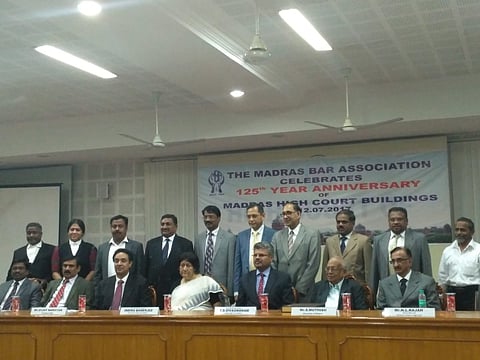
- Latest Legal News
- News
- Dealstreet
- Viewpoint
- Columns
- Interviews
- Law School
- Legal Jobs
- हिंदी
- ಕನ್ನಡ

The Madras High Court celebrated the 125th anniversary of the inauguration of its historic buildings last evening. The celebrations were organized by the Madras Bar Association.
The event was graced by the presence of Chief Justice Indira Banerjee, Justice TS Sivagnanam, and Senior Advocates Vijay Narayan and NL Rajah on the dais, as well as former Attorney General for India K Parasaran.
The evening was marked by a dual sense of respect for the historic significance which shrouds the Madras High Court, as well as wonder in appreciating the beauty of its architecture.
The welcome address was rendered by Senior Advocate and President of the Madras Bar Association, Vijay Narayan, who lauded the efforts of the Heritage Committee in preserving the architectural integrity of the High Court premises.
Following the presentation of mementos to the dignitaries, the gathering was addressed by Justice TS Sivagnanam, Chairman of the Heritage Committee. He observed that the Madras High Court can be said to have the rare distinction of being one of the few heritage structures that is still fully functional as well as fairly well-maintained.
In her presidential address, Chief Justice Indira Banerjee noted that the Madras High Court remains one of the “finest examples of Indo-Saracenic architecture.” The inauguration of the present premises took place on 12th July, 1892, when the erstwhile Governor of Madras, Baron Belby Wenlock formally handed over its keys to the then Chief Justice Arthur Collins.
The Chief Justice also emphasized on the contemporary relevance of the then Governor’s words on the occasion, that it was hoped that judges “will be devoted to carrying on one of the noblest of works, the uninterrupted administration of justice.” She expressed hope that the institution will continue to deliver timely and quality justice without fear or favour.
The pervasive historical significance of the Madras High Court was further elaborated on by prominent Chronicler for Madras, S Muthiah. Terming the buildings as a “memorial to justice in the state”, he recounted that the court, among other things, was the site for the first instance of jury trial in the country, in the Ascentia Dawes case.
It was remarked that the remembrance of its origins is important, as people should be made aware that Madras itself is a historical city. Former Attorney General for India K Parasaran was also present and expressed pride in having the Madras High Court as his parent court.
Senior Advocate NL Rajah, Chronicler of the Madras High Court, drew attention to four parameters which distinguish the High Court: its unique architecture, its historical import, as an edifice to cases of great Constitutional consequence, and as an institution that has nurtured several stalwarts who have contributed immensely to the country.
In addition, he also pointed out that there is symbolic significance embedded within the base structure. An elephant surrounded by owls on either side stands for wisdom and strength in judgment. Intertwining snakes designed within the court have undertones of karmic significance, following Hindu mythology. Swans incorporated elsewhere stand for the need to separate truth from falsehood, and the use of truth alone as the basis for judgment.
Holding that there are rich traditions to be upheld in the Madras High Court, he concluded his speech by referring to the quote of Chief Justice Arthur Collins (responding to Governor Baron Belby),
“I fervently hope that long after you and I, Your Excellency, have passed away to that undiscovered country, of which we know so little, there may also continue to be found men of ability and courage, who will administer the law in these Courts without distinction of class, creed or race.”
The vote of thanks was delivered by VR Kamalanathan, Secretary of the Madras Bar Association.